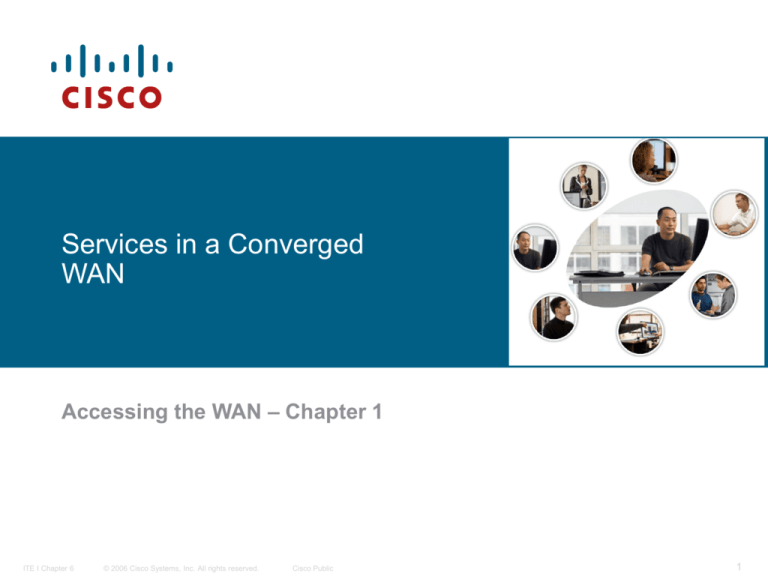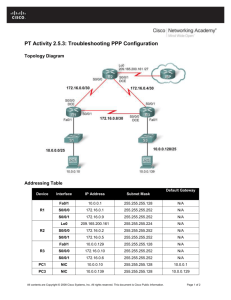
Services in a Converged
WAN
Accessing the WAN – Chapter 1
ITE I Chapter 6
© 2006 Cisco Systems, Inc. All rights reserved.
Cisco Public
1
Objectives
Describe how the Cisco Enterprise Composite
Model (ECNM) provides integrated services
over an Enterprise network.
Describe the key WAN technology concepts.
Identify the appropriate WAN technologies to
use when matching ECNM best practices with
typical enterprise requirements for WAN
communications.
ITE 1 Chapter 6
© 2006 Cisco Systems, Inc. All rights reserved.
Cisco Public
2
Describe How ECNM Provides Integrated
Services over an Enterprise Network
Explain the purpose and function of WANs
ITE 1 Chapter 6
© 2006 Cisco Systems, Inc. All rights reserved.
Cisco Public
3
Describe How ECNM Provides Integrated
Services over an Enterprise Network
Business growth
ITE 1 Chapter 6
© 2006 Cisco Systems, Inc. All rights reserved.
Cisco Public
4
Describe How ECNM Provides Integrated
Services over an Enterprise Network
Cisco Enterprise Network Architecture Modules
ITE 1 Chapter 6
© 2006 Cisco Systems, Inc. All rights reserved.
Cisco Public
5
Describe How ECNM Provides Integrated
Services over an Enterprise Network
Explain the purpose of Cisco Enterprise Architectures
ITE 1 Chapter 6
© 2006 Cisco Systems, Inc. All rights reserved.
Cisco Public
6
Describe the Key WAN Technology
Concepts
Describe WAN functions in terms of the OSI Reference
Model
ITE 1 Chapter 6
© 2006 Cisco Systems, Inc. All rights reserved.
Cisco Public
7
Describe the Key WAN Technology
Concepts
ITE 1 Chapter 6
© 2006 Cisco Systems, Inc. All rights reserved.
Cisco Public
8
WAN Data-Link-Layer protocols
ITE 1 Chapter 6
© 2006 Cisco Systems, Inc. All rights reserved.
Cisco Public
9
Describe the Key WAN Technology
Concepts
Describe the switching technologies used for WANs in
an Enterprise setting
ITE 1 Chapter 6
© 2006 Cisco Systems, Inc. All rights reserved.
Cisco Public
10
Connecting subscribers to WAN link
ITE 1 Chapter 6
© 2006 Cisco Systems, Inc. All rights reserved.
Cisco Public
11
Select the Appropriate WAN Technology to meet
ECNM Requirements
Describe how Enterprises use leased line services to
provide a WAN connection
ITE 1 Chapter 6
© 2006 Cisco Systems, Inc. All rights reserved.
Cisco Public
12
Circuit Switching options
ITE 1 Chapter 6
© 2006 Cisco Systems, Inc. All rights reserved.
Cisco Public
13
Packet switching options
ITE 1 Chapter 6
© 2006 Cisco Systems, Inc. All rights reserved.
Cisco Public
14
Factors to consider in WAN
ITE 1 Chapter 6
© 2006 Cisco Systems, Inc. All rights reserved.
Cisco Public
15
Summary
A WAN is defined as
A data communications network that operates beyond the
geographic scope of a LAN
WAN primarily operate on layer 1 & 2 of the OSI model
WAN technologies include
–Leased line
–ISDN
–Frame relay
–X.25
–ATM
ITE 1 Chapter 6
© 2006 Cisco Systems, Inc. All rights reserved.
Cisco Public
16
Summary
Cisco Enterprise Architecture
–This is an expansion of the hierarchical model that further
divides the enterprise network into
•Physical areas
•Logical areas
•Functional areas
Selecting the appropriate WAN technology requires
considering some of the following:
–WAN’s purpose
–Geographic scope of WAN
–Traffic requirements
–If WAN uses a public or private infrastructure
ITE 1 Chapter 6
© 2006 Cisco Systems, Inc. All rights reserved.
Cisco Public
17
ITE 1 Chapter 6
© 2006 Cisco Systems, Inc. All rights reserved.
Cisco Public
18
Point-to-Point Protocol
(PPP)
Accessing the WAN – Chapter 2
ITE I Chapter 6
© 2006 Cisco Systems, Inc. All rights reserved.
Cisco Public
19
Objectives
Describe the fundamental concepts of point-to-point serial
communication including TDM, demarcation point, DTE-DCE
functions, HDLC encapsulation, and serial interface
troubleshooting.
Describe PPP concepts including PPP layered architecture, PPP
frame structure, PPP session establishment, multiprotocol
encapsulation support, link control protocol (LCP), network
control protocol (NCP), and Internet Protocol Control Protocol
(IPCP).
Configure PPP on a serial interface including enabling PPP
encapsulation, verifying the PPP connection and troubleshooting
encapsulation problems.
Configure PPP authentication including explaining PAP and
CHAP authentication protocols, configuring PPP authentication
using PAP and CHAP, and troubleshooting PPP authentication
problems.
ITE 1 Chapter 6
© 2006 Cisco Systems, Inc. All rights reserved.
Cisco Public
20
Describe the Fundamental Concepts of
Point-to-Point Serial Communication
Describe the concept of serial communication as the
basis of WAN technologies
ITE 1 Chapter 6
© 2006 Cisco Systems, Inc. All rights reserved.
Cisco Public
21
Describe the Fundamental Concepts of
Point-to-Point Serial Communication
Explain how two or more data streams are transported
across a single physical connection using TDM
ITE 1 Chapter 6
© 2006 Cisco Systems, Inc. All rights reserved.
Cisco Public
22
Describe the Fundamental Concepts of
Point-to-Point Serial Communication
Define the location of the demarcation point relative to
customer and service provider networks
ITE 1 Chapter 6
© 2006 Cisco Systems, Inc. All rights reserved.
Cisco Public
23
Describe the Fundamental Concepts of
Point-to-Point Serial Communication
Explain the terms DTE and DCE with relative to the
location of devices in a network
ITE 1 Chapter 6
© 2006 Cisco Systems, Inc. All rights reserved.
Cisco Public
24
Describe the Fundamental Concepts of
Point-to-Point Serial Communication
Describe how high-level data link control (HDLC) uses
one of three frame types to encapsulate data
ITE 1 Chapter 6
© 2006 Cisco Systems, Inc. All rights reserved.
Cisco Public
25
Describe the Fundamental Concepts of
Point-to-Point Serial Communication
Explain when and how to configure HDLC
encapsulation on a router
ITE 1 Chapter 6
© 2006 Cisco Systems, Inc. All rights reserved.
Cisco Public
26
Describe Point-to-Point Concepts
Describe PPP in terms of its use in WAN links
ITE 1 Chapter 6
© 2006 Cisco Systems, Inc. All rights reserved.
Cisco Public
27
Describe Point-to-Point Concepts
Describe the general function of each layer of PPP
architecture
ITE 1 Chapter 6
© 2006 Cisco Systems, Inc. All rights reserved.
Cisco Public
28
Describe Point-to-Point Concepts
Define the three phases of PPP session establishment
ITE 1 Chapter 6
© 2006 Cisco Systems, Inc. All rights reserved.
Cisco Public
29
Describe Point-to-Point Concepts
Explain the role of the LCP in PPP
ITE 1 Chapter 6
© 2006 Cisco Systems, Inc. All rights reserved.
Cisco Public
30
Describe Point-to-Point Concepts
ITE 1 Chapter 6
© 2006 Cisco Systems, Inc. All rights reserved.
Cisco Public
31
Configuring PPP with Authentication
Differentiate between PAP and CHAP
ITE 1 Chapter 6
© 2006 Cisco Systems, Inc. All rights reserved.
Cisco Public
32
Configuring PPP with Authentication
Describe how to use PAP to authenticate a PPP
connection
ITE 1 Chapter 6
© 2006 Cisco Systems, Inc. All rights reserved.
Cisco Public
33
Configuring PPP with Authentication
Describe how to use CHAP to authenticate a PPP
connection
ITE 1 Chapter 6
© 2006 Cisco Systems, Inc. All rights reserved.
Cisco Public
34
Configuring PPP with Authentication
Outline the PPP encapsulation and authentication
process on a flow chart
ITE 1 Chapter 6
© 2006 Cisco Systems, Inc. All rights reserved.
Cisco Public
35
Configuring PPP
ITE 1 Chapter 6
© 2006 Cisco Systems, Inc. All rights reserved.
Cisco Public
36
Configuring PPP with Authentication
Explain how to configure a PPP connection with
authentication
ITE 1 Chapter 6
© 2006 Cisco Systems, Inc. All rights reserved.
Cisco Public
37
Configuring PPP with PAP Authentication
Left(config)# interface Serial 0/0
Left(config-if)# ip address 192.168.1.1 255.255.255.252
Left(config-if)# encapsulation ppp
Left(config-if)# ppp authentication pap
Right(config)# interface Serial 0/0
Right(config-if)# ip address 192.168.1.2 255.255.255.252
Right(config-if)# encapsulation ppp
Right(config-if)# ppp authentication pap
Configuration of Serial interface, addressing scheme
ITE 1 Chapter 6
© 2006 Cisco Systems, Inc. All rights reserved.
Cisco Public
38
Configuring PPP with PAP Authentication
Left(config)# interface Serial 0/0
Left(config-if)# ip address 192.168.1.1 255.255.255.252
Left(config-if)# encapsulation ppp
Left(config-if)# ppp authentication pap
Right(config)# interface Serial 0/0
Right(config-if)# ip address 192.168.1.2 255.255.255.252
Right(config-if)# encapsulation ppp
Right(config-if)# ppp authentication pap
Activation of PPP encapsulation, specify authentication type
ITE 1 Chapter 6
© 2006 Cisco Systems, Inc. All rights reserved.
Cisco Public
39
Configuring PPP with PAP Authentication
Left(config-if)# encapsulation ppp
Left(config-if)# ppp authentication pap
Left(config-if)# ppp pap sent-username Left password LE
Right(config-if)# encapsulation ppp
Right(config-if)# ppp authentication pap
Right(config-if)# ppp pap sent-username Right password RI
Set credentials that are sent during authentication
ITE 1 Chapter 6
© 2006 Cisco Systems, Inc. All rights reserved.
Cisco Public
40
Configuring PPP with PAP Authentication
Left(config-if)# encapsulation ppp
Left(config-if)# ppp authentication pap
Left(config-if)# ppp pap sent-username Left password LE
Left(config)# username Right password RI
Right(config-if)# encapsulation ppp
Right(config-if)# ppp authentication pap
Right(config-if)# ppp pap sent-username Right password RI
Right(config)# username Left password LE
Set credentials, that are verified during authentication
ITE 1 Chapter 6
© 2006 Cisco Systems, Inc. All rights reserved.
Cisco Public
41
Configuring PPP with CHAP Authentication
Left(config-if)# encapsulation ppp
Left(config-if)# ppp authentication chap
Left(config-if)# ppp chap hostname Left
Left(config-if)# ppp chap password LE
Left(config)# username Right password RI
What is the difference when
Configuring the same witch CHAP?
Right(config-if)# encapsulation ppp
Right(config-if)# ppp authentication chap
Right(config-if)# ppp chap hostname Right
Right(config-if)# ppp chap password RI
Right(config)# username Left password LE
ITE 1 Chapter 6
© 2006 Cisco Systems, Inc. All rights reserved.
Cisco Public
42
Configure PPP on a Serial Interface
Explain the output of the show interfaces serial
command
ITE 1 Chapter 6
© 2006 Cisco Systems, Inc. All rights reserved.
Cisco Public
43
Configure PPP on a Serial Interface
Explain the output of the debug ppp command
ITE 1 Chapter 6
© 2006 Cisco Systems, Inc. All rights reserved.
Cisco Public
44
Debugging PPP
Explain the output of the debug ppp authentication
command
ITE 1 Chapter 6
© 2006 Cisco Systems, Inc. All rights reserved.
Cisco Public
45
Summary
PPP is a widely used WAN protocol
PPP provides multi-protocol LAN to WAN connections
PPP session establishment – 4 phases
Link establishment
Link quality determination
Network layer protocol configuration negotiation
Link termination
WAN Encapsulation
–HDLC default encapsulation
–PPP
ITE 1 Chapter 6
© 2006 Cisco Systems, Inc. All rights reserved.
Cisco Public
46
Summary
PPP authentication
–PAP
•2 way handshake
–CHAP
•3 way handshake
–Use debug ppp authentication to confirm authentication
configuration
PPP configuration
–Done on a serial interface
After PPP configuration, use show interfaces command
to display:
–LCP state
–NCP state
ITE 1 Chapter 6
© 2006 Cisco Systems, Inc. All rights reserved.
Cisco Public
47
ITE 1 Chapter 6
© 2006 Cisco Systems, Inc. All rights reserved.
Cisco Public
48




